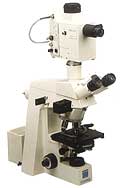CSU10 revolutionizes the world of Confocal fluorescence microscope.
A confocal microscopy has enabled z-axis resolution of a thick specimen by employing pin-point illumination and pin-point detection while both the illumination and detection of a conventional optical microscopy are planar. However, it typically takes around I second to produce one confocal image using most of the existing confocal microscope; which is too slow to observe movement of living cells in real time. Now, as fast as 360 frames/sec. scanning speed and high S/N design of Yokogawa Model CSU10 enables direct viewing of clear-cut confocal images of fluorescent specimens in real time at its eyepiece. The confocal images captured by CSU10 can be recorded either by a video camera as live images or by a film camera as real-color photographs. Using CSU10 is as easy as using regular microscopes: you set it on a microscope, change the light path: that's all. You can mount CSU10 on most of the currently used microscopes.
microscopeFast Scanning Rate at 360 frames/sec.
- High-Resolution with High S/N
- Direct Viewing of Clear-Cut Confocal Images
- Easy Operation Without Computer Control
- Mountable on Any Microscopes
Details
Confocal scanning method of CSU10 is based on the Nipkow disk scanner(1884); an optical scanner using rotation of a disk with pinholes to produce an image. While a Nipkow scanner is good at fast scanning, its optical efficiency is too low to capture dark fluorescent images.By placing a microlens array in front of the Nipkow disk, we greatly improved the optical efficiency about two orders. In addition,CSU10 is designed to minimize the background inside the system thus realized high S/N.
Fast scanning, high optical efficiency and high S/N in the system: these are the key factors to realize the direct viewing of clear-cut confocal images in CSU10!
CSU10 has two disks; one with about 20,000 microlenses, the other with pin-holes arranged in the same pattern as the microlenses. Light incident on the upper disk is focused by the microlenses on corresponding pinholes. The two disks rotate together at 1,800 rpm by an electrical motor so that the light beams raster-scan the specimen. The light passing through the pinhole is focused by an objective lens on a spot in the specimen. Fluorescent light from the specimen returns along the same path through the objective lens and the pinhole, and reflected by the dichroic mirror through a relay lens to the imaging point in a camera or eye. Both the laser beam and the emitted fluorescent light pass through a pinhole, thus CSU10 can produces 2-dimensional confocal images at such high speed. The pinhole pattern is designed to capture 12 frames per rotation, which means 360 frames per second of confocal images can be captured with CSU10.

Best for tracking fast movement/reactions of living cells in real-time, but also good at capturing clear-cut cross sections.
Observation and recording of fluorescent images in real-time of:
- Ca2+ signals in living cells and/or organs.
- blood circulation in living animals.
- movement/reactions in microorganisms or plant cells, especially stained with GFP.
Recording clear-cut cross sections of:
- whole-mount embryo
- pathological or histological specimens
And MORE!
- Images of Sea Urchin Embryonic Microtubules at the First Mitotic Stage
- Images of Living Cell
- Real-Time Observation
News
-
Press Release Jun 10, 2016 Yokogawa Develops CSU-SR Confocal Scanner Unit
- A Yokogawa solution for the super-resolution imaging of live cells -
Looking for more information on our people, technology and solutions?
Contact Us